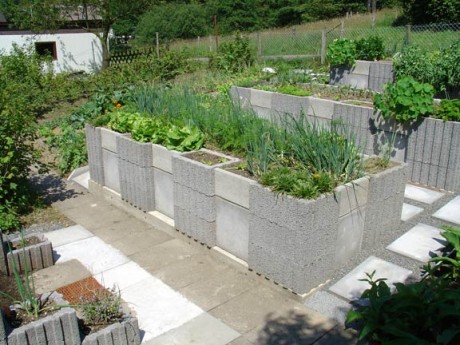The No-Dig Gardening Alternative
Say goodbye to tilling, digging and costly garden chemicals
By John Bruce
No-dig gardening is a proven way to grow vegetables and flowers naturally — and with less work.
No-dig gardeners realize that worms, bugs and microbes are necessary for nutrients and prevention of disease. Plants deliver into the soil part of the carbon energy they produce. Microbes convert this energy into organic materials and minerals that plants need.
The rationale for traditional row gardening and tilling is to remove weeds, loosen and aerate the soil and bury organic matter. Tilling can remove existing weeds, but it almost always brings dormant weed seeds to the surface where they can germinate. When organic materials are moved deeper, less oxygen is available for converting the materials into nutrients. Then the nutrients need to be replaced. Traditional gardeners usually rely on synthetic fertilizers to amend the soil and replace the lost nutrients.
No-dig gardening lets nature do the work. One strategy is first to remove all weeds and grass from a garden area. Materials such as rotten manure, decayed sawdust or compost go straight on the surface as a layer of mulch 2 to 6 inches deep. Worms, beneficial bugs and microbes get busy beefing up the soil. They create a healthy habitat for roots to flourish.
Newspapers & mulch
Celebrated no-dig gardening author Patricia Lanza bubbles over with enthusiasm when she explains why gardeners should consider the shovel-free approach. She gardens in Tennessee.
"As an old hand at this game of gardening, I remember my own 'Ahhhh!' moment when I put all the pieces together that allowed me to make wonderful growing spaces without the use of power tools or purchased material," Lanza says. "Whether you choose to layer, grid, mulch or straw bale, you can't go wrong. Just do it!"
Lanza says with no-dig methods, there's less fuss over the planting area. Free organic material, such as grass clippings and compost, are used in layers on top of a newspaper ground cover. Don't cut through the paper before planting.
First, Lanza recommends picking a spot and marking it (a garden should receive six to eight hours of sunlight and not be subject to strong wind). Cover the area with thick layers of wet newspapers, overlapped. Cover the paper with several inches each of peat moss, compost, grass clippings, chipped leaves, humus, spoiled hay, seaweed, aged manure or whatever is handy.
Water the layers of organic material until they feel like a squeezed-out sponge. Pull the layers back to the paper. Place your plants on the paper and pull the organic material back around the plant roots. Press the soil to push out the air and water. Try to use one part nitrogen-rich material (grass clippings, compost or manure) to four parts carbon-rich material (chopped leaves, peat moss, straw, spoiled hay or peat humus) for a perfect mix. Use what is readily available and free.
Sheet mulching
A similar no-dig method is sheet mulching. Newspaper or cardboard is spread out on the garden area and topped with landscape mulch. Again, weeds should be removed first if there's no time to let them die out and decay under a new blanket of sheet mulch.
Sheet mulch blocks daylight and suffocates existing grass and weeds that, over time, decompose (before the actual sheets do) to become part of the biosphere that garden plants need to thrive. Ideally, the newspaper or cardboard should be spread out before a heavy rain, but otherwise a garden hose can do what's necessary to keep the sheet thoroughly wet. When ready to plant, use a hand shovel to cut out holes for planting seeds or seedlings.
Raised beds
Raised-bed gardening — essentially planting in containers made of wood or masonry and filled with compost or manufactured soils — has been in practice for centuries. Like other no-dig approaches, raised-bed gardening keeps soil aerated, allows for more crops to grow in less space, reduces weeding and requires less fertilizer than traditional row gardens.
Four-foot-wide raised-beds put the working space within easy reach from both sides for most gardeners, but beds can be narrower for children to help. Length can vary according to preference. Raised beds can be elevated on tables or other platforms to ease accessibility for folks who find it uncomfortable to stoop or kneel.
Square foot gardens
Square-foot gardening is a spin on the raised-bed method. A typical square foot garden consists of a framed 4-foot-square raised-bed, divided into 16 one-foot squares — ideal for limited space. Wooden strips divide the bed into a grid that provides plants in each square enough growing room as well as separation. Each section is planted with a different crop. The number of seeds or seedlings per square varies according to plant size.
Upside down gardens
Another limited-space, no-dig alternative is a hanging (upside-down) garden. Five-gallon buckets are good for tomatoes and cucumbers. Essentially it involves drilling a two-inch hole in the bottom, placing a slit coffee filter over the hole, inserting an inverted seedling through the slit (so the root ball faces up), filling the bucket with a compost-soil mixture and hanging the bucket from a tall post in a sunny spot. Low growing spices or flowers can go in the top of the bucket. You also can buy kits for upside-down gardening.
Websites with no-dig gardening tips
www.no-dig-vegetablegarden.com
www.motherearthnews.com/Organic-Gardening/2008-06-01/No-Dig-Garden-Beds.aspx
-
Share this story:


